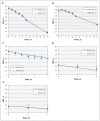Individualized prediction of lung-function decline in chronic obstructive pulmonary disease
- PMID: 27486205
- PMCID: PMC5047815
- DOI: 10.1503/cmaj.151483
Individualized prediction of lung-function decline in chronic obstructive pulmonary disease
Abstract
Background: The rate of lung-function decline in chronic obstructive pulmonary disease (COPD) varies substantially among individuals. We sought to develop and validate an individualized prediction model for forced expiratory volume at 1 second (FEV1) in current smokers with mild-to-moderate COPD.
Methods: Using data from a large long-term clinical trial (the Lung Health Study), we derived mixed-effects regression models to predict future FEV1 values over 11 years according to clinical traits. We modelled heterogeneity by allowing regression coefficients to vary across individuals. Two independent cohorts with COPD were used for validating the equations.
Results: We used data from 5594 patients (mean age 48.4 yr, 63% men, mean baseline FEV1 2.75 L) to create the individualized prediction equations. There was significant between-individual variability in the rate of FEV1 decline, with the interval for the annual rate of decline that contained 95% of individuals being -124 to -15 mL/yr for smokers and -83 to 15 mL/yr for sustained quitters. Clinical variables in the final model explained 88% of variation around follow-up FEV1. The C statistic for predicting severity grades was 0.90. Prediction equations performed robustly in the 2 external data sets.
Interpretation: A substantial part of individual variation in FEV1 decline can be explained by easily measured clinical variables. The model developed in this work can be used for prediction of future lung health in patients with mild-to-moderate COPD.
Trial registration: Lung Health Study - ClinicalTrials.gov, no. NCT00000568; Pan-Canadian Early Detection of Lung Cancer Study - ClinicalTrials.gov, no. NCT00751660.
© 2016 Canadian Medical Association or its licensors.
Figures


Comment in
-
Predicting individual lung-function trajectories: An opportunity for prevention?CMAJ. 2016 Oct 4;188(14):997-998. doi: 10.1503/cmaj.160611. Epub 2016 Aug 2. CMAJ. 2016. PMID: 27486212 Free PMC article. No abstract available.
Similar articles
-
Decline in FEV1 and hospitalized exacerbations in individuals with severe alpha-1 antitrypsin deficiency.Int J Chron Obstruct Pulmon Dis. 2019 May 23;14:1075-1083. doi: 10.2147/COPD.S195847. eCollection 2019. Int J Chron Obstruct Pulmon Dis. 2019. PMID: 31213789 Free PMC article.
-
An Individualized Prediction Model for Long-term Lung Function Trajectory and Risk of COPD in the General Population.Chest. 2020 Mar;157(3):547-557. doi: 10.1016/j.chest.2019.09.003. Epub 2019 Sep 19. Chest. 2020. PMID: 31542453
-
Acute Exacerbations and Lung Function Loss in Smokers with and without Chronic Obstructive Pulmonary Disease.Am J Respir Crit Care Med. 2017 Feb 1;195(3):324-330. doi: 10.1164/rccm.201605-1014OC. Am J Respir Crit Care Med. 2017. PMID: 27556408 Free PMC article. Clinical Trial.
-
The value of forced expiratory volume in 1 second decline in the assessment of chronic obstructive pulmonary disease progression.Am J Med. 2006 Oct;119(10 Suppl 1):4-11. doi: 10.1016/j.amjmed.2006.08.002. Am J Med. 2006. PMID: 16996894 Review.
-
Female smokers beyond the perimenopausal period are at increased risk of chronic obstructive pulmonary disease: a systematic review and meta-analysis.Respir Res. 2006 Mar 29;7(1):52. doi: 10.1186/1465-9921-7-52. Respir Res. 2006. PMID: 16571126 Free PMC article.
Cited by
-
Machine Learning Prediction of Progression in Forced Expiratory Volume in 1 Second in the COPDGene® Study.Chronic Obstr Pulm Dis. 2022 Jul 29;9(3):349-365. doi: 10.15326/jcopdf.2021.0275. Chronic Obstr Pulm Dis. 2022. PMID: 35649102 Free PMC article.
-
The association between non-high-density lipoprotein cholesterol to high-density lipoprotein cholesterol ratio and preserved ratio impaired spirometry: NHANES 2007-2012.Lipids Health Dis. 2025 Apr 25;24(1):157. doi: 10.1186/s12944-025-02571-0. Lipids Health Dis. 2025. PMID: 40281503 Free PMC article.
-
Predicting individual lung-function trajectories: An opportunity for prevention?CMAJ. 2016 Oct 4;188(14):997-998. doi: 10.1503/cmaj.160611. Epub 2016 Aug 2. CMAJ. 2016. PMID: 27486212 Free PMC article. No abstract available.
-
Evaluation of clinical variables according to follow-up times in COPD: results from ON-SINT cohort.Eur Clin Respir J. 2017 Nov 2;4(1):1394132. doi: 10.1080/20018525.2017.1394132. eCollection 2017. Eur Clin Respir J. 2017. PMID: 29201289 Free PMC article.
-
The Construction of Primary Screening Model and Discriminant Model for Chronic Obstructive Pulmonary Disease in Northeast China.Int J Chron Obstruct Pulmon Dis. 2020 Jul 31;15:1849-1861. doi: 10.2147/COPD.S250199. eCollection 2020. Int J Chron Obstruct Pulmon Dis. 2020. PMID: 32801682 Free PMC article.
References
-
- Global strategy for the diagnosis, management, and prevention of chronic obstructive pulmonary disease: clinical practice guidelines. Revised, 2014. Global Initiative for Chronic Obstructive Lung Disease; 2014. - PubMed
-
- World Health Report. Geneva: World Health Organization; 2000. Available: www.who.int/whr/2000/en/whr00_en.pdf (accessed 2016 July 22).
-
- Vestbo J, Edwards LD, Scanlon PD, et al. ; ECLIPSE Investigators. Changes in forced expiratory volume in 1 second over time in COPD. N Engl J Med 2011;365:1184–92. - PubMed
-
- Lange P, Celli B, Agustí A, et al. Lung-function trajectories leading to chronic obstructive pulmonary disease. N Engl J Med 2015;373:111–22. - PubMed
-
- Anderson KM, Odell PM, Wilson PWF, et al. Cardiovascular disease risk profiles. Am Heart J 1991;121:293–8. - PubMed
MeSH terms
Associated data
LinkOut - more resources
Full Text Sources
Other Literature Sources
Medical
